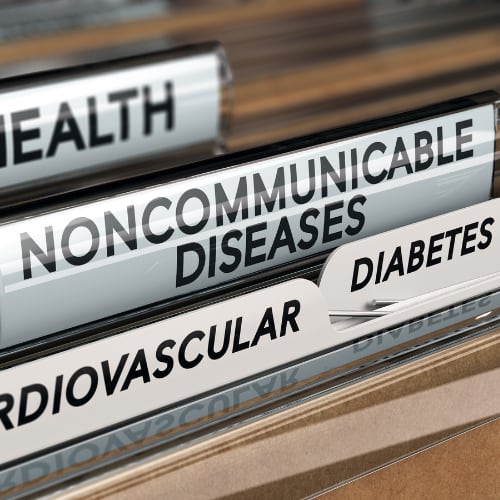 The Global Rise of Lifestyle Diseases
The Global Rise of Lifestyle Diseases
The Global Rise of Lifestyle Diseases

-
Main Ideas
Learning Objective
Understand the causes and consequences of lifestyle diseases and identify strategies to prevent or mitigate their impact.
Behavioral Objective
Adopt healthier lifestyle practices, such as increased physical activity and improved dietary choices, to reduce the risk of developing lifestyle diseases.
Key Thought
Lifestyle diseases are preventable, and small, consistent changes in daily habits can lead to significant health improvements and a better quality of life.
-
Main Ideas
Learning Objective
Understand the causes and consequences of lifestyle diseases and identify strategies to prevent or mitigate their impact.
Behavioral Objective
Adopt healthier lifestyle practices, such as increased physical activity and improved dietary choices, to reduce the risk of developing lifestyle diseases.
Key Thought
Lifestyle diseases are preventable, and small, consistent changes in daily habits can lead to significant health improvements and a better quality of life.
-
Terms
- Lifestyle Diseases
noun
Non-communicable diseases caused by unhealthy behaviors, such as poor diet, sedentary habits, and chronic stress, including obesity, type 2 diabetes, and heart disease.
- Non-Communicable Diseases (NCDs)
noun
Chronic diseases not spread from person to person, typically caused by genetic, environmental, and behavioral factors, such as cardiovascular diseases and diabetes.
- Processed Diets
noun
Eating patterns that heavily rely on foods altered through industrial processing, often high in sugar, unhealthy fats, and sodium.
- Sedentary Lifestyle
noun
A way of living characterized by minimal physical activity, often linked to desk jobs, excessive screen time, and lack of exercise.
- Urbanization
noun
The process of rural areas transforming into urban centers, often associated with lifestyle changes that may negatively impact health.
-
Terms
- Lifestyle Diseases
noun
Non-communicable diseases caused by unhealthy behaviors, such as poor diet, sedentary habits, and chronic stress, including obesity, type 2 diabetes, and heart disease.
- Non-Communicable Diseases (NCDs)
noun
Chronic diseases not spread from person to person, typically caused by genetic, environmental, and behavioral factors, such as cardiovascular diseases and diabetes.
- Processed Diets
noun
Eating patterns that heavily rely on foods altered through industrial processing, often high in sugar, unhealthy fats, and sodium.
- Sedentary Lifestyle
noun
A way of living characterized by minimal physical activity, often linked to desk jobs, excessive screen time, and lack of exercise.
- Urbanization
noun
The process of rural areas transforming into urban centers, often associated with lifestyle changes that may negatively impact health.
Introduction
Lifestyle diseases, including obesity, type 2 diabetes, and cardiovascular conditions, are on the rise worldwide. Unlike infectious diseases, these conditions are primarily driven by unhealthy habits such as poor diet, lack of physical activity, and chronic stress. This topic explores the factors contributing to their prevalence, their impact on global health, and actionable steps to combat them.
What Are Lifestyle Diseases?
Lifestyle diseases, also known as non-communicable diseases (NCDs), result from prolonged exposure to unhealthy behaviors. These conditions develop gradually and are often preventable through lifestyle modifications. The most common lifestyle diseases include:
- Obesity: Excess body weight is caused by an imbalance between calorie intake and energy expenditure.
- Type 2 Diabetes: A chronic condition where the body becomes resistant to insulin or fails to produce enough of it.
- Cardiovascular Diseases: Conditions affecting the heart and blood vessels, such as hypertension and coronary artery disease.
Key Drivers of Lifestyle Diseases
The increasing prevalence of lifestyle diseases can be attributed to several factors:
- Sedentary Habits: Modern work environments and technology have reduced physical activity levels, leading to weight gain and other health issues.
- Processed Diets: Diets high in sugar, unhealthy fats, and refined carbohydrates contribute to obesity and metabolic disorders.
- Chronic Stress: Persistent stress disrupts hormonal balance, weakens the immune system, and promotes unhealthy coping mechanisms like overeating.
- Urbanization: Rapid urban growth has led to environments that prioritize convenience over health, such as fast-food access and limited recreational spaces.
The Impact of Lifestyle Diseases
Lifestyle diseases have significant consequences for individuals and society, including:
- Healthcare Costs: Treating chronic conditions places a heavy burden on healthcare systems, especially in low- and middle-income countries.
- Reduced Quality of Life: Patients often experience limitations in daily activities, reduced mobility, and dependence on medications.
- Economic Impact: Lost productivity due to illness or premature death affects families, businesses, and national economies.
Addressing Lifestyle Diseases
While the rise of lifestyle diseases is alarming, it is also preventable. Strategies to address these conditions include:
- Promoting Physical Activity: Encouraging regular exercise through workplace initiatives, community programs, and accessible fitness facilities.
- Adopting Whole-Food Diets: Educating individuals on the benefits of balanced diets rich in fruits, vegetables, lean proteins, and whole grains.
- Stress Management: Teaching stress-reduction techniques, such as mindfulness, yoga, and counseling.
- Public Health Campaigns: Raising awareness about lifestyle diseases and advocating for policies that promote healthier environments.
Conclusion
The global rise of lifestyle diseases represents a critical public health challenge but also offers an opportunity for change. By addressing the root causes through education, policy, and community engagement, we can reduce the prevalence of these conditions and build healthier societies. The first step to combating lifestyle diseases starts with small, intentional changes in daily habits.
Global Rise of Lifestyle Diseases Quiz
Can small habits spark big health problems?
The Global Rise of Lifestyle Diseases challenges you to spot the behaviors-like poor diet, inactivity, stress, and urban living-that fuel conditions such as obesity, type 2 diabetes, and heart disease. Test your knowledge of their causes, impacts, and prevention strategies in ten rapid-fire questions.
Get instant feedback, then consult your personalized Remediation Map to turn insights into healthier daily habits.
Diet Analysis
Objective: Identify dietary habits contributing to lifestyle diseases and explore healthier alternatives.
- Keep a food diary for one week, tracking all meals, snacks, and beverages consumed.
- Analyze your intake of processed foods, sugar, and unhealthy fats.
- Research whole-food alternatives and create a sample meal plan to reduce reliance on processed diets.
Exercise Habit Tracker
Objective: Promote regular physical activity to combat sedentary behaviors.
- Use a fitness tracker or mobile app to monitor your daily steps, exercise time, and calories burned for one week.
- Set achievable activity goals, such as a 10-minute daily walk or three weekly workout sessions.
- Evaluate your progress and adjust goals to maintain consistency in physical activity.
Stress and Lifestyle Assessment
Objective: Examine how stress affects lifestyle habits and health outcomes.
- Identify three common stressors in your daily life.
- Record how these stressors influence your diet, exercise, and sleep patterns over one week.
- Research and implement one stress-reduction technique, such as mindfulness, yoga, or journaling.
Global Health Comparison
Objective: Understand the prevalence and impact of lifestyle diseases across different countries.
- Choose two countries with contrasting rates of lifestyle diseases (e.g., the U.S. and Japan).
- Research factors contributing to these differences, such as diet, exercise culture, and public health policies.
- Present your findings and propose strategies to reduce the prevalence of lifestyle diseases in high-risk regions.
Public Awareness Campaign
Objective: Educate others about the risks of lifestyle diseases and promote healthy habits.
- Create a poster, infographic, or social media post highlighting the causes and prevention of lifestyle diseases.
- Include practical tips for reducing sedentary time, improving diet, and managing stress.
- Share your campaign with peers or online communities to encourage health-conscious decisions.
Course Outline
![]() Session Expired from Inactivity
Session Expired from Inactivity
Do you want to?
9618 Jefferson Highway, Suite D-191
Baton Rouge LA 70809-9636
(888) 424-0032 |
support@supplementrelief.com
* Disclaimer: This page is available exclusively for SupplementRelief.com clients. None of the information on this website is intended to replace your relationship with your healthcare provider(s). Nothing should be considered medical advice. The information, knowledge, and experience shared on this website are the opinions of SupplementRelief.com. This site and its content are intended to enhance your knowledge base as YOU MAKE YOUR OWN HEALTHCARE DECISIONS in partnership with your qualified health professional.
* These statements have not been evaluated by the Food and Drug Administration. These products and services are not intended to diagnose, treat, cure, or prevent disease.
* There is NO GUARANTEE OF SPECIFIC RESULTS for the products or services offered, and the RESULTS CAN VARY for each individual. Any results claimed by our customers are based on individual experiences that are unique and cannot be guaranteed.
FirstFitness Nutrition and NuMedica may be promoted and sold on the internet ONLY by Authorized Resellers who have been approved by and have registered their website domain with these companies. They strictly prohibit, and actively monitor, the UNAUTHORIZED SALE or RESALE of their products in ALL online public shopping portals including Amazon, eBay, and others and into other countries. All products purchased in SupplementRelief.com are for PERSONAL USE ONLY and CANNOT BE RESOLD to others. Please report violations of Reseller Policy directly to FirstFitness Nutrition at 800.621.4348 and to NuMedica at 800.869.8100.
The content and photographs on this website are copyrighted or Licensed Material and may not be downloaded for other than personal use. Republication, retransmission, reproduction, or any other use of the content or photographs is prohibited. ©2010-2024 SupplementRelief.com.
Are you sure you want to remove this item?


